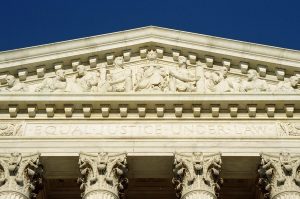Many construction projects are subject to the regulatory requirements of the Clean Water Act (CWA), including the  determination whether an earth-moving operation is covered by a “dredge and fill” permits administered by the U.S. Army Corps of Engineers. If there is a question about the applicability of the CWA to a project, the of Corps of Engineers will determine, on its own initiative or following a request for a determination by the project sponsor, whether or not the project is subject to the CWA. However, the administrative procedures employed by the Corps of Engineers to decide whether the project is covered can often be so costly and time-consuming that the project may be abandoned. Now, in the case of the U.S. Amy Corps of Engineers v. Hawkes Co., Inc., decided May 31, the Supreme Court has acknowledged some of these costs, and the serious legal consequences that attend these proceedings, as it has ruled that in appropriate cases, a controversial jurisdictional determination by Corps officials that a project is covered by the CWA is subject to judicial review by the federal courts.
determination whether an earth-moving operation is covered by a “dredge and fill” permits administered by the U.S. Army Corps of Engineers. If there is a question about the applicability of the CWA to a project, the of Corps of Engineers will determine, on its own initiative or following a request for a determination by the project sponsor, whether or not the project is subject to the CWA. However, the administrative procedures employed by the Corps of Engineers to decide whether the project is covered can often be so costly and time-consuming that the project may be abandoned. Now, in the case of the U.S. Amy Corps of Engineers v. Hawkes Co., Inc., decided May 31, the Supreme Court has acknowledged some of these costs, and the serious legal consequences that attend these proceedings, as it has ruled that in appropriate cases, a controversial jurisdictional determination by Corps officials that a project is covered by the CWA is subject to judicial review by the federal courts.
When Contract is Silent, Accommodation Doctrine Applies to Water Rights Disputes
A case that has been closely followed by oil and gas and other interests which involves groundwater disputes has now been decided by the Texas Supreme Court. In Coyote Lake Ranch, LLC, v. The City of Lubbock, decided on May 27, the Court held that the “accommodation doctrine,” a doctrine developed by the courts to assist in the resolution of disputes between landowners and their oil and gas lessees, can play a significant role in the resolution of disputes between landowners and the owner of an interest in the groundwater beneath the land. The doctrine refers to the rule that “[a]bsent an agreement to the contrary, an oil-and-gas lessee has an implied right to use the land as reasonably necessary to produce and remove the minerals but must exercise that right with due regard for the landowner’s rights. In so ruling, the Court reversed the U.S. Court of Appeals for the Seventh District sitting in Amarillo, Texas.
Remembrance, May 30, 2016
At the age of 21, in 1861, Oliver Wendell Holmes, Jr. and many of his friends enlisted in the Massachusetts Infantry after the outbreak of the Civil War. He saw the worst of the war, and was nearly killed several times and suffered two grave wounds. By 1864, at the end of his enlistment, he had had his fill of it. Yet his experience left an indelible mark on him, as it did on most of his contemporaries, and he was grateful for the opportunity to serve his county in these great battles. Throughout his long life, he would recall where he was, on a day 50 or 60 years before, when the anniversaries of such battles as Balls Bluff and Antietam triggered his memories. Continue Reading ›
outbreak of the Civil War. He saw the worst of the war, and was nearly killed several times and suffered two grave wounds. By 1864, at the end of his enlistment, he had had his fill of it. Yet his experience left an indelible mark on him, as it did on most of his contemporaries, and he was grateful for the opportunity to serve his county in these great battles. Throughout his long life, he would recall where he was, on a day 50 or 60 years before, when the anniversaries of such battles as Balls Bluff and Antietam triggered his memories. Continue Reading ›
Design-Build Contractors Get Ready to Go Back to School
For bid requests issued on or after July 1, 2016, California school districts, with approval of their governing board,  may procure design-build contracts for projects in excess of $1M, awarding the contract to either the low bid or the best value. The threshold currently is $2.5M. The new threshold was enacted as part of Assembly Bill 1358 (Dababneh) and will remain in place until January 1, 2025, unless a later enacted statute deletes or extends that date. As those in the industry already familiar, “design-build” refers to “a project delivery process in which both the design and construction of a project are procured from a single entity.” Design-build contractors should also take note that the new law will require that certain information is verified under penalty of perjury.
may procure design-build contracts for projects in excess of $1M, awarding the contract to either the low bid or the best value. The threshold currently is $2.5M. The new threshold was enacted as part of Assembly Bill 1358 (Dababneh) and will remain in place until January 1, 2025, unless a later enacted statute deletes or extends that date. As those in the industry already familiar, “design-build” refers to “a project delivery process in which both the design and construction of a project are procured from a single entity.” Design-build contractors should also take note that the new law will require that certain information is verified under penalty of perjury.
Photo: Alan Levine, School, Taken May 24, 2012 – Creative Commons
Ready, Set: Time to Add Ready-Mixed Concrete to “Public Works” Definition
Public works contracts awarded on or after July 1, 2016 will be subject to the more expansive definition of public works added by California Assembly Bill 219 (Daly). For purposes of Article 2 of California’s Labor Code, commencing with Section 1770, the term “public works” will include “the hauling and delivery of ready-mixed concrete to carry out a public works contract, with respect to contracts involving any state agency, including the California State University and the University of California, or any political subdivision of the state.” Those who will be encompassed within the new definition will be required to pay the applicable prevailing wage rate, which will be the rate for the geographic area in which the concrete factory or batching plant is located, and to provide employee payroll and time records, as specified.
Cybersecurity Changes Are Rolling In With Waves of Legislation
In A New Cybersecurity Regime and a New Regulation to Mandate Secure Information Systems for Government Contractors,  my colleague Travis Mullaney and I discuss Congress’ recent enactment of a wave of legislation to address ongoing cybersecurity threats, the Executive Branch’s recent adoption of new cybersecurity regulations, and other Federal initiatives that are underway and that will bring additional promised change requiring enhanced cybersecurity protections. In our Advisory, we discuss what government contractors need to do to prepare for these changes.
my colleague Travis Mullaney and I discuss Congress’ recent enactment of a wave of legislation to address ongoing cybersecurity threats, the Executive Branch’s recent adoption of new cybersecurity regulations, and other Federal initiatives that are underway and that will bring additional promised change requiring enhanced cybersecurity protections. In our Advisory, we discuss what government contractors need to do to prepare for these changes.
Photo: Intel Free Press, Computer Security, Taken Sep. 4, 2012 – Creative Commons
Commonality and Cohesiveness Lacking for Class Contamination Claims
On May 20, 2016, the U.S. Court of Appeals for the Eighth Circuit, in Ebert, et al., v. General Mills, Inc., reversed the federal district court’s decision to grant class certification in an environmental contamination lawsuit. The district court had found that the requisites of Federal Rule of Civil Procedure 23 had been satisfied with respect to the proposed class of “all persons and non-governmental entities that own residential property within the ‘Class Area.'” The proposed class members were expected to assert five legal claims: (1) violation of the Comprehensive Environmental Response, Compensation, and Liability Act (CERCLA); (2) common law negligence; (3) private nuisance; (4) willful and wanton misconduct; and (5) violation of the Resource Conservation and Recovery Act (RCRA). The Eight Circuit disagreed with the district courts findings, instead concluding that the proposed class lacks the requisite commonality and cohesiveness to satisfy Rule 23.
Minimum Salaries Increase Under DOL’s Final Rule For EAP and HCE Exemptions
In U.S. Department of Labor More Than Doubles Minimum Salary Levels for FLSA Overtime Exemptions, Pillsbury attorneys Julia Judish, Rebecca Carr Rizzo and John Scalia discuss the U.S. Department of Labor’s much-anticipated Final Rule amending the Fair Labor Standards Act regulations implementing the exemption from minimum wage and overtime pay for executive, administrative, and professional employees (EAP) and for highly compensated employees (HCE). A projected 4.2 million exempt employees may be impacted by the new rule. Employers have six months to come into compliance with the new rule.
Things Getting Hot for Massachusetts Department of Environmental Protection
On May 17, 2016, the Supreme Judicial Court of Massachusetts, in Isabel Kain & Others v. Department of Environmental Protection, held that the various existing greenhouse gas rules and initiatives promulgated by the Commonwealth of Massachusetts Department of Environmental Protection (DEP) did not satisfy the strict requirements of the state’s Global Warming Solutions Act. The purpose of the Act “is to attain actual, measurable, and permanent emissions reductions in the Commonwealth.” According to the Court, the unambiguous language of Section 3 (d) of the Act “requires the department to promulgate regulations that establish volumetric limits on multiple greenhouse gas emissions sources, expressed in carbon dioxide equivalents, and that such limits must decline on an annual basis.” DEP’s duty under the law was described by DEP as being mostly aspirational, but the Court held this was insufficient.
104(e) Letter Triggers Duty to Defend
According to the Ninth Circuit Court of Appeals, in Ash Grove Cement Co. v. Liberty Mutual Ins. Co., an unpublished opinion applying Oregon law, an insurer’s duty to defend begins with a “104(e) letter” from the EPA and continues for the duration of the regulatory process. In A “Suit” by Any Other Name: Ninth Circuit Rules CERCLA 104(e) Letter Triggers Duty to Defend, Pillsbury attorney Alex Lathrop discusses the Ash Grove ruling.




